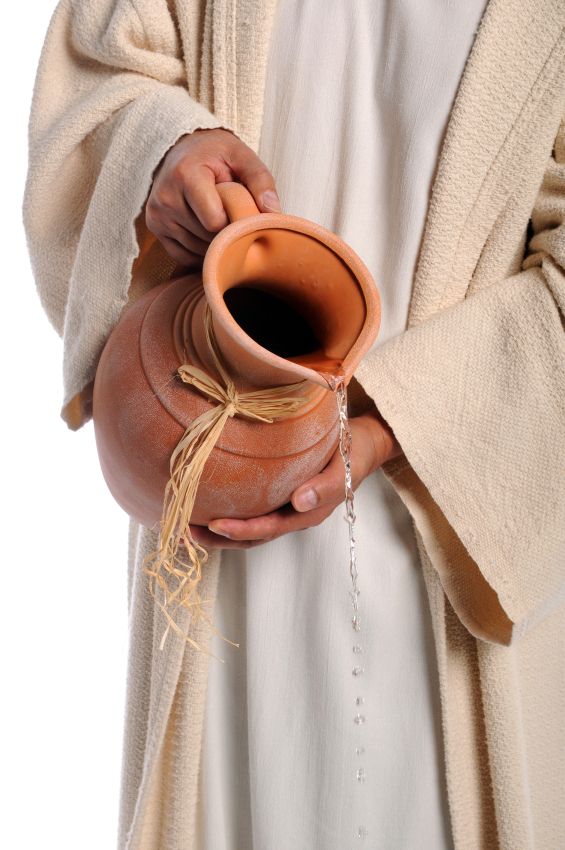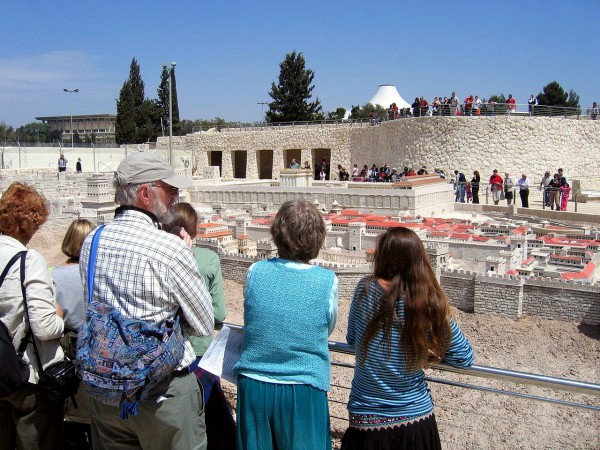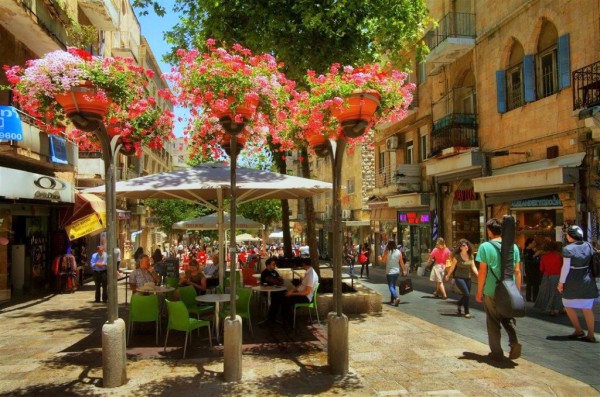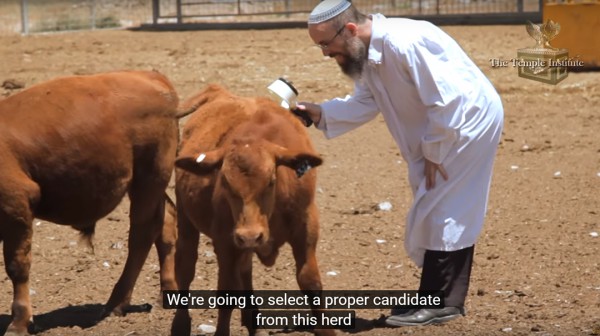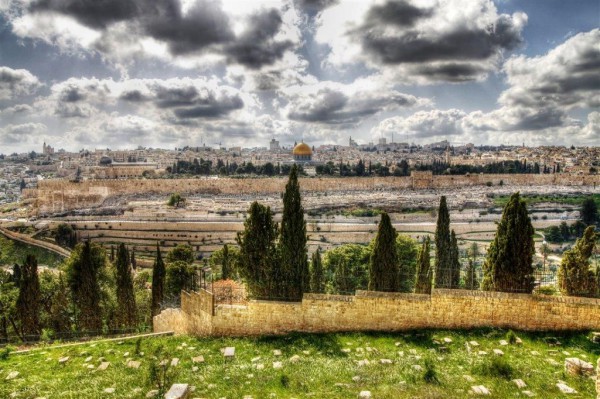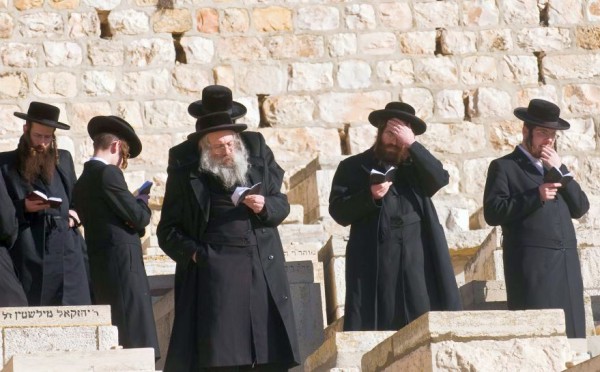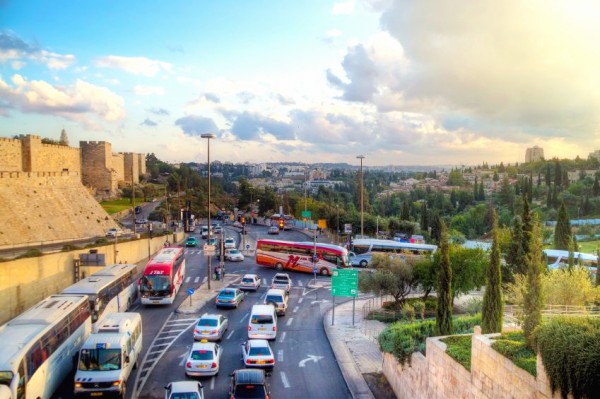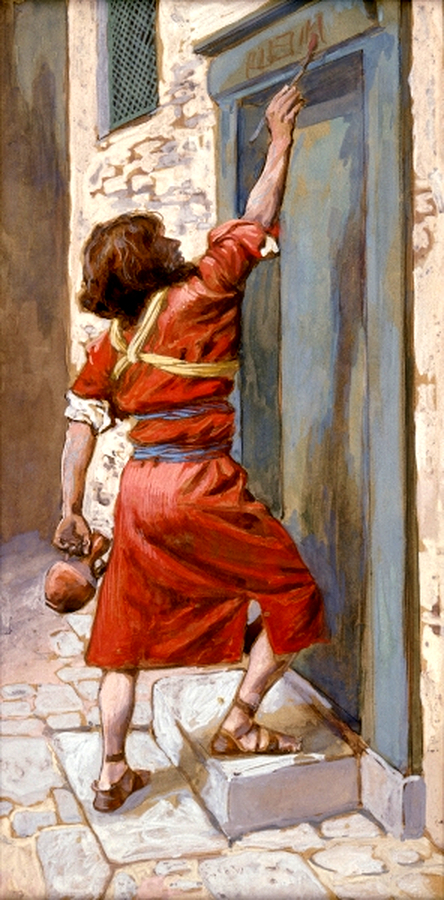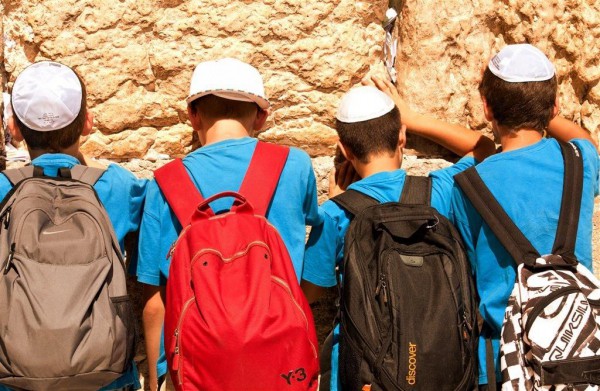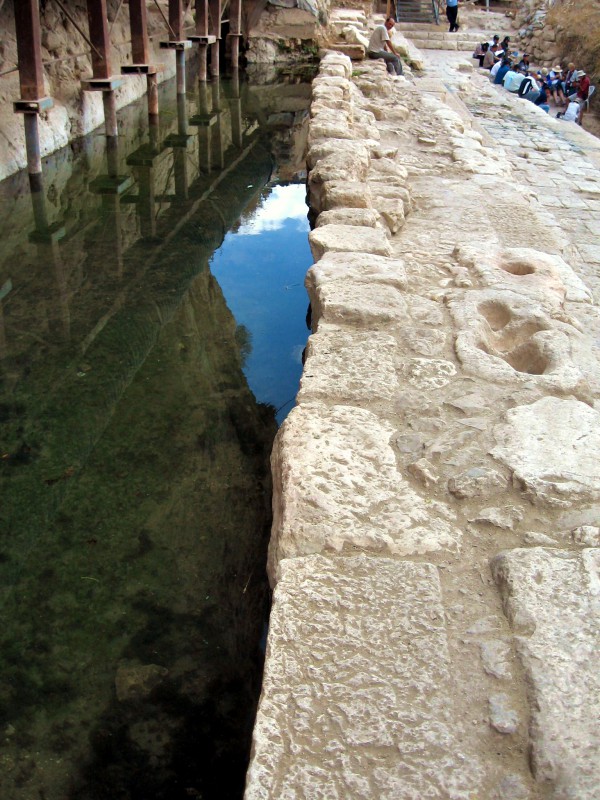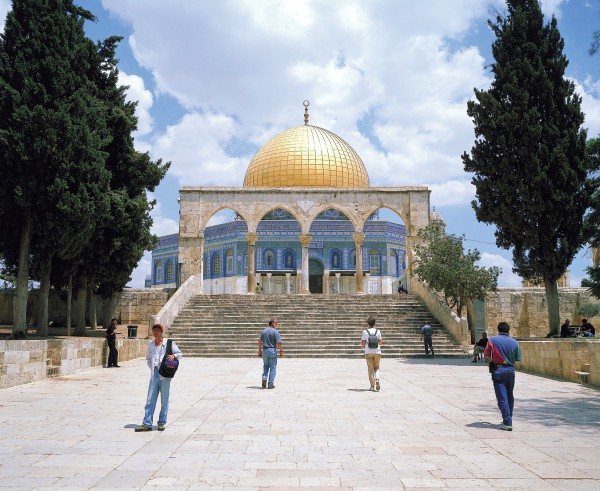A model of the Jerusalem Temple
“This is a requirement of the law that the Lord has commanded: Tell the Israelites to bring you a red heifer without defect or blemish and that has never been under a yoke.” (Numbers 19:2)
After disqualifying several hopeful candidates to fulfill the “ordinance of the red heifer” (Numbers 19), the Temple Institute announced last year that “it’s time to stop waiting and start doing.”
“After decades of intensive study and research, the Institute has partnered with an Israeli cattleman, and using state-of-the-art techniques and under strict rabbinical supervision, we are going to raise a herd of red cows here in Israel,” said the Institute’s director, Rabbi Chaim Richman.
“We are going to select a proper candidate from this herd for the fulfillment of the biblical requirements of the commandments of the red heifer,” he added.
Such a Red Heifer or Parah Adumah is a prerequisite for the restoration of ritual purity and the ultimate resumption of the Divine service in the Holy Temple.
In recent years, several red heifers have been born around the world, but each one has been disqualified for one reason or other.
Building a holy Temple and worshiping in it are not permitted by God without the restoration of ceremonial purity, which is only possible with ashes of the Red Heifer mixed with the purification water necessary for restoring ritual purity or ceremonial cleanliness.
“The God of Israel determined through His wisdom that the ashes of the Red Heifer is the secret to the restoration of purity in the world,” red-heifer expert and Temple Institute director Rabbi Chaim Richman told institute employee Yitzchak Reuven in an audio recording.
“There is a tradition that all throughout history there were nine perfect red heifers that were used for the cleansing and the purification, and that the appearance of the tenth red heifer is associated with the advent of the messianic era, and the rebuilding of the Temple,” Richman said. “We look forward to the fulfillment of the verse in Ezekiel 36:25–26:
“Then I shall sprinkle pure waters upon you and you shall be clean from all your uncleanness, and from all your idols will I cleanse you. I will also give you a new heart and I will place within you a new spirit.” (Ezekiel 36:25–26)
“Let us draw near to God with a sincere heart and with the full assurance that faith brings, having our hearts sprinkled to cleanse us frommore...
Yearning for the Red Heifer and the Third Temple
Building and worshiping in a holy Temple is not permitted by God without the restoration of ceremonial purity. This can only be accomplished with the ashes of the Red Heifer, which are used to create the Biblically required purification water.
And without a Temple, several end-time prophecies remain unfulfilled (Ezekiel 40–48; 2 Thessalonians 2:3–4; Revelation 11:1–2).
The prophet Haggai indicates a connection between the building of the Temple and peace in the Holy Land. As a result, many Jews today believe that the Holy Temple is the only solution for achieving the peace that currently seems so elusive.
“The latter glory of this house shall be greater than the former, says the LORD of hosts. And in this place I will give peace, declares the LORD of hosts.” (Haggai 2:9)
Indeed, there is also a traditional connection between the Third Temple and the Coming of the Prince of Peace. Even Israel’s sages state that when the Messiah comes, He will stand on the roof of the Temple and cry out: “Humble ones! The time of your redemption has arrived!”
The search for the Red Heifer, therefore, is intimately linked to the desire for redemption, the Messiah, and the Messianic Era.
“Purification with the red heifer reminds us that man has the potential to rise above his transitory physical existence, with all its false sense of hopelessness and misery … the ‘impurity’ of death,” states the Temple Institute.
“This is the role of the Third Temple for all mankind, and this is the Messianic vision of the future: the call to live an eternal life, liberated from the sham and unhappiness which is the sum total of the human condition for so many people. The call for the true joy of living life to the fullest—with the knowledge of God.”
The Institute site continues to say, “The Divine ordinance of the heifer, beyond the grasp of man’s frail intellect, with all the details of its preparation and ceremony, calls out to Israel and to all who seek to cling to the living word of the God of Israel: ‘Purify yourselves! Shake off your despair! Death is an illusion!’ Thus it is written, ‘… but all of you who cling to the Lord your God are all alive today.’” (Deuteronomy 4:4)
A Jewish man prays at the Western (Wailing) Wall wearing tefillin (phylacteries). (Photo credit: Go Israel, Noam Chen)
The Deepest Mystery of the Torah
“Therefore you shall do My statutes and keep My rules and perform them, and then you will dwell in the land securely.” (Leviticus 25:18)
Judaism considers the Red Heifer to be the deepest mystery of the Torah.
The commandment for it, which is found in Numbers 19, belongs to a category of Biblical ordinances called chok (plural, chukim).
Chukim are statutes that transcend human reasoning and include the chok not to wear a mixture of wool and linen. It also includes kosher dietary rules and prohibitions, such as the chok not to eat pork.
Chukim differ from mishpatim, which are laws forbidding theft, murder, taking bribes, etc.
While mishpatim ordinances seem self-evident, the true meaning of chukim are thought to be beyond our intellectual grasp.
The ashes of the Red Heifer cleanse a person from the most serious form of contamination—death and, therefore, also sin, which is the spiritual contamination that causes physical death.
Paradoxically, all of the ritually pure who are involved in the preparation of the ashes of the cow become ritually impure when they come in contact with the very same ashes.
A Temple institute expert inspects this red heifer in Israel’s breeding program for signs of discoloration or other imperfection that would disqualify it as a candidate to fulfill the biblical requirements of the red heifer. (YouTube capture)
The Process of Purification
“Then I shall sprinkle pure waters upon you, and you shall be clean, from all your uncleanness, and from all your idols, will I cleanse you. I will also give you a new heart, and I will place within you a new spirit.” (Ezekiel 36:25–26)
Numbers 19 describes the slaughtering and preparation process for the red-heifer purification offering, given by God as “a lasting ordinance both for the Israelites and for the foreigners residing among them.” (Numbers 19:10)
God told Moses that the sacrificial altar of the Red Heifer was to be built “outside” the camp, 2000 cubits (2,916 feet) to the east of the tent tabernacle.
In Yeshua’s day, that altar was atop the Mount of Olives, although no ruins of the altar that existed then remain today.
The Red Heifer Bridge led from the Temple Mount to the Mount of Olives, where the priest would have had a direct view over the East Gate and the inner east gate, looking for the signal as to when to begin the sacrifice.
According to the Bible, the altar was to be made of unhewn natural stone from the immediate area. It also was to have four walls and be filled in with layers of stone until it had a flat surface on top, with a ramp, not steps, leading to it.
A Temple priest would oversee the cow being slaughtered outside the camp; then, taking some of its blood on his finger, would sprinkle the blood seven times toward the Temple.
The priest would then watch as the cow’s “hide, flesh, blood and intestines” were burned into ashes, throwing onto the offering “some cedar wood, hyssop and scarlet wool.” (Numbers 19:5–6)
The priest and the one conducting the heifer’s burning would have become impure through these tasks, and each would have had to wash his clothes and bathe in water before reentering the camp, remaining unclean until evening—the new day.
Finally, a third man, who was clean until touching the ashes, would “gather up the ashes of the heifer and put them in a ceremonially clean place outside the camp. They are to be kept by the Israelite community for use in the water of cleansing; it is for purification from sin.” (Numbers 19:9)
Just as the bodies of the sin offerings were burned outside the camp, the ashes remained in a clean place also outside the camp until later required by members of the community.
For that reason, still today, archaeologists and other determined people are searching for the ashes of the last Red Heifer, thought to be hidden still in a cave since about AD 15, somewhere in the vicinity of Jerusalem or the Temple Mount.
According to the Bible, one of the sources of tumah, or ritual impurity, is contact with death. Anyone contaminated by it remained unclean for seven days. On the third and seventh days, they were to be sprinkled with the water. At sunset on the last day, they were clean again. The person who performedmore...
Leviticus 17 examines the need to perform sacrifices to God with the spilling of innocent blood, while outlining a careful method of slaughtering animals that ensures no guilt for bloodshed.
God required that even animals that are hunted for food must not be eaten with their blood, but should be drained and the blood covered with earth—an act some Jewish thinkers suggest could illustrate disgust and shame for spilling blood. Even today, properly removing the blood is required to earn kosher status.
In fact, the three men conducting the red-heifer purification offering became unclean from being in contact with death, and had to cleanse themselves before returning to the camp.
For those who failed to purify themselves after touching a dead person or grave would “defile the Lord’s tabernacle. They must be cut off from Israel. Because the water of cleansing has not been sprinkled on them, they are unclean.” (Numbers 19:13)
The message of the Red Heifer is that God is holy and He is served and worshiped by a holy people.
Cleanse Me and I Will Be Cleansed
“The priest is to take some cedar wood, hyssop and scarlet wool and throw them onto the burning heifer.” (Numbers 19:6)
During the sacrifice of the Parah Adumah, cedar wood, hyssop and scarlet wool were thrown onto the burning sacrifice. Each of these items still remain necessary ingredients for purification from death for Jews who are awaiting the Messianic era.
We see these same ingredients mentioned in Leviticus 14. In this passage, they are paired with the blood of a clean bird for the purification of a person once leprous and for a house once moldy.
In Psalm 104:16, the Psalmist cites the aromatic cedars of Lebanon as “the trees of the Lord … that He planted,” while the hyssop carries both the symbolic and the actual characteristics of cleansing.
Hyssop was also used in Egypt to help save the firstborns from death.
“Take a bunch of hyssop, dip it into the blood in the basin and put some of the blood on the top and on both sides of the doorframe. None of you shall go out of the door of your house until morning.” (Exodus 12:22)
The use of hyssop in the Passover, the sacrifices, and the ceremonial cleansing rituals painted a detailed “picture of the washing, cleansing, saving, purification, and salvation from death itself that come only from the eternal God.” (Forerunner)
The author of Hebrews also acknowledges hyssop’s role in God’s forming a covenant with His people—and the sanctifying act thereof.
“When Moses had proclaimed every command of the law to all the people, he took the blood of calves, together with water, scarlet wool and branches of hyssop, and sprinkled the scroll and all the people. He said, ‘This is the blood of the covenant, which God has commanded you to keep.’” (Hebrews 9:18–20)
Thus, we see David in Psalm 51 requesting that the Lord wash him and make him pure with hyssop, acknowledging that God is the One Who Cleanses.
“Surely I was sinful at birth, sinful from the time my mother conceived me. … Cleanse me with hyssop, and I will be clean; wash me, and I will be whiter than snow.” (Psalm 51:5, 7)
Jewish children pray at the Western (Wailing) Wall in Jerusalem, which is part of an ancient wall that once surrounded the Temple’s courtyard. (Photo: Go Israel)
White As Snow: Signs of the Messiah
Throughout the Tanakh (Old Covenant), being purified from sin is synonymous with the color white, and the purification rituals required by God point to the final cleansing of sin by the Messiah.
Leviticus 16 describes Aaron confessing the sins of Israel onto the head of a scapegoat, which was selected to be taken into the wilderness—to “carry on itself all their sins to a remote place.” (Leviticus 16:22)
According to the Talmud, scarlet wool would be tied to the head of the scapegoat on the Day of Atonement and when it supernaturally turned white, it would serve as a Divine sign to the Jewish people that their sins were forgiven.
This happened consistently until around 30 AD, the time of Yeshua’s death on the Roman execution stake.
“The Rabbis taught that forty years prior to the destruction of the Temple the lot did not come up in the (high priest’s) right hand nor did the tongue of scarlet wool become white…,“ writes the Talmud in Tractate Yoma 39b.
“‘Come now, let us settle the matter,’ says the Lord. ‘Though your sins are like scarlet, they shall be as white as snow; though they are red as crimson, they shall be like wool.’” (Isaiah 1:18)
The Mishnah (rabbinic compilation of Jewish oral law) states that water for the Red Heifer ritual came from the Pool of Siloam in the timemore...
Another color change happened naturally when the Red Heifer’s body was completely burned; its ashes turned white and was mixed with pure water called Living Water. Only then was it sprinkled on the people to purify them from the contamination of contact with death and sin.
When we accept the cleansing of our sins through the blood of Yeshua—who is the source of pure Living Water—we, too, become white.
“These are the ones who died in the great tribulation. They have washed their robes in the blood of the Lamb and made them white.” (Revelation 7:14)
And just as the Red Heifer was sacrificed outside the camp, so was Yeshua.
“The high priest carries the blood of animals into the Most Holy Place as a sin offering, but the bodies are burned outside the camp. And so Yeshua also suffered outside the city gate to make the people holy through His own blood.” (Hebrews 13:11–12)
Leviticus 17:11 confirms, “it is the blood that makes atonement for one’s life.”
Although the Dome of the Rock is situated on the Temple Mount in the very spot that the ancient Holy of Holies was once located, the Bible indicates that a Jewish Temple will be on the Temple Mount and connects it to the coming of the Messiah. (Photo credit: Go Israel)
While Yeshua’s sacrifice brought us purification for our sin, Biblical prophecies about the last days ensure that the Temple sacrifices will resume before Messiah’s return.
The prophet Ezekiel describes his vision of the Temple to which the glory of God would come with His voice “like the roar of rushing waters, and the land … radiant with His glory.” (Ezekiel 43:2)
Upon the restoration of the Temple and the Great Altar, described by Ezekiel in minute detail, the Lord gives specific regulations for sacrificing burnt offerings and splashing blood against the altar when it is built:
“You are to give a young bull as a sin offering to the Levitical priests of the family of Zadok, who come near to minister before Me, declares the Sovereign Lord. You are to take some of its blood and put it on the four horns of the altar and on the four corners of the upper ledge and all around the rim, and so purify the altar and make atonement for it. You are to take the bull for the sin offering and burn it in the designated part of the temple area outside the sanctuary.” (Ezekiel 43:18–20)
The purification offering of the red heifer will follow a similar course. This offering will be re-instituted according to the Biblical pattern, and its blood will be used to purify the place and tools of worship. It will be burned outside God’s holy sanctuary in the pattern of ancient times.
Many continue to wait in expectation for the red heifer that will help prompt the rebuilding of God’s Holy Temple and be used to set the stage for future worship in God’s House.
That day is not far off.

